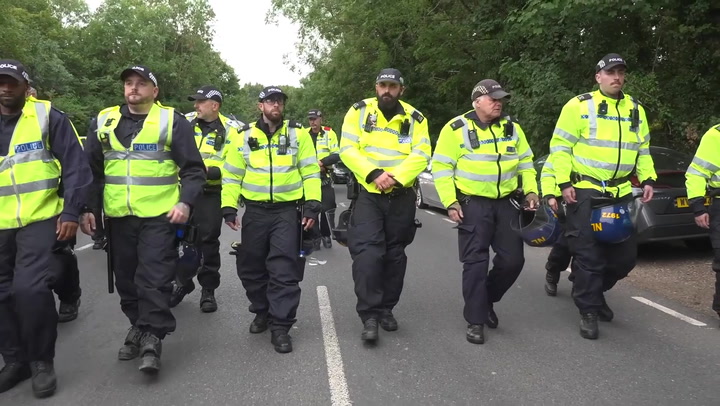Is a 4.2% pay rise enough for UK police officers? A critical analysis

UK police officers get 4.2% pay rise, but critics say it won’t fix deeper challenges in the force.
The recently announced 4.2% pay increase for police officers in England and Wales has been presented by the UK government as a gesture of recognition and appreciation for officers’ continued dedication and hard work. Backed by £120 million in Home Office funding, the pay rise applies to all ranks up to chief superintendent. While this increase appears to match the current inflation rate of 4.1%, a deeper analysis shows that it may be insufficient in addressing the long-standing challenges faced by police personnel, especially when viewed against the backdrop of economic pressures, workforce morale, and structural demands on the force.
Real-Term Value vs. Cumulative Losses
Although the 4.2% increase aligns with the Consumer Price Index, it merely helps officers keep pace with inflation rather than actually improving their financial well-being. Over the past decade, police officers in the UK have suffered a steady erosion of real-terms pay due to a combination of pay freezes, below-inflation raises, and surging living costs. The Police Federation estimates that officers have lost over 20% of their income in real terms since 2010. This historical decline in earnings means that even with the current increase, police officers remain financially behind compared to their earnings a decade ago. As such, the latest raise may prevent further deterioration, but it does little to restore the financial ground that has already been lost.
READ ALSO
Police officers in England and Wales to receive 4.2% pay rise… what this means
Morale and Workforce Retention
Pay has a direct impact on morale, motivation, and the ability to retain skilled personnel. In recent years, UK policing has faced a serious retention and recruitment crisis, with rising numbers of officers leaving the force voluntarily. Between 2021 and 2023, voluntary resignations increased by over 70%, a statistic that underscores deep dissatisfaction within the ranks. Mental health-related absences are also on the rise, with many officers citing stress, burnout, and inadequate support systems. The Police Federation described the latest pay rise as equivalent to “a Big Mac per shift,” underscoring the perception that the increase is largely symbolic. Without more meaningful financial incentives, the police force will continue to lose experienced officers while struggling to attract qualified recruits into a demanding and high-risk profession.
Funding Realities and Operational Impact
While the government’s £120 million funding allocation is meant to support this pay rise and prevent police forces from cutting essential services, there is uncertainty about its sustainability. Policing budgets are already stretched, with approximately 85% of expenditures going toward salaries. If funding for the pay rise is not sustained beyond this financial year, forces may be forced to make difficult choices—such as cutting frontline services, scaling back training, or delaying investment in technology and infrastructure. A one-time financial boost may offer temporary relief, but without a consistent and long-term funding model, operational efficiency and community policing may suffer. In essence, the pay rise must be part of a broader, sustainable funding framework to ensure that service delivery is not compromised in the future.
Cost of Living and Regional Variations
The effectiveness of a flat 4.2% pay rise is also questionable when viewed in the context of regional cost-of-living differences. In high-cost areas like London, where housing, childcare, and transportation costs are significantly higher, even the parallel 4.2% rise in London weighting may fall short of what is needed to retain officers in the capital. Many officers are increasingly finding it difficult to live in or near the communities they serve, pushing them toward relocation or even career changes. This undermines the principle of community policing, where familiarity and local engagement are critical. A more tailored approach that accounts for regional disparities in living costs might be necessary to ensure fairness and improve retention in high-pressure urban areas.
Political Significance vs. Practical Impact
There is also a strong argument to be made that the pay award is politically timed, serving to project an image of a government that supports “law and order” ahead of a general election. While political optics may benefit from such gestures, the practical realities remain largely unchanged for officers on the ground. Without a transparent and evidence-based review of police pay structures, and a mechanism for ensuring fairness in future salary negotiations, the government risks deepening the disconnect between political rhetoric and frontline experience. Symbolic gestures do little to mend fractured relationships or rebuild morale, particularly when trust in leadership has already been eroded by years of stagnation and austerity.
Conclusion: A Step, Not a Solution
In conclusion, while the 4.2% pay rise for UK police officers provides short-term financial relief, it does not adequately address the structural, psychological, and economic challenges currently facing the force. It is a welcome gesture, but not a transformative one. To truly support the police workforce and rebuild public trust in the institution, the government must pursue deeper reforms. These should include a transparent and consistent pay review mechanism, sustained funding commitments, robust mental health support, and investment in modern policing tools. Without these, the current pay rise will be remembered as a missed opportunity—an insufficient step when a bold, systemic solution was needed most.

